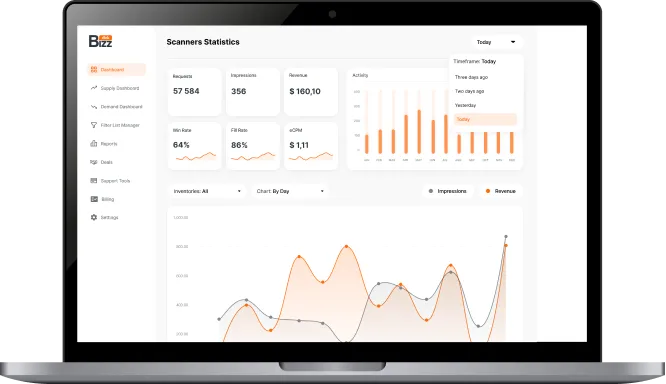No More Cookies: the Future of Targeted Ads
.webp)
They said it would be the end of programmatic ads…
The AdTech landscape is undergoing a significant transformation as browsers increasingly phase out third-party cookies. These small text files were instrumental in tracking user behavior and delivering targeted ads. However, growing concerns over data privacy and the rise of privacy-centric regulations have led to a shift away from third-party cookies.
As major web browsers like Safari and Firefox have already phased out third-party cookies, and Google Chrome is set to follow suit in 2023, advertisers, publishers and marketers are adapting to a cookieless future. While the situation may seem deplorable at first glance, you should not be discouraged. Our article explains how to get out of the situation.
Methods of Targeted Ads Without Cookies
Contextual Advertising: A Privacy-Conscious Approach
Contextual advertising offers a promising solution in the cookieless era. This method involves placing ads on websites based on their content and relevance to the user's interests. For instance, an ad for workout apparel could be displayed on a webpage discussing the benefits of regular exercise.
In 2021, global contextual advertising spending was around $178.3 billion. It is projected to surpass $376.2 billion by 2027. The United States, with a market value of about $52 billion in 2020, holds the position of the largest contextual advertising spending.
Contextual advertising doesn't rely on tracking individual user behavior, making it a privacy-friendly alternative to behavioral targeting. Additionally, contextual ads are often more relevant to the user's current interests, leading to a more engaging and effective advertising experience.
The Power of the First-Party Data
First-party data, collected directly from customers, plays a crucial role in the cookieless future. Brands can leverage this data to create detailed audience profiles and understand customer preferences. By segmenting their audience based on first-party data, advertisers can deliver personalized marketing messages that resonate with their target audience.
First-party data is valuable for understanding and engaging with customers, but it also presents several challenges. These challenges include data silos, poor data quality, limited scale, privacy concerns, data governance issues, monetization challenges, data decay, and ethical considerations. You need to address these challenges to effectively leverage your first-party data and maximize its value.
Leveraging Cohorts for Effective Targeting
Cohorts, groups of users with shared characteristics, provide a valuable tool for targeted advertising in the cookieless world. Marketers can create cohorts based on various factors, such as demographics, purchase history, and website behavior. By targeting cohorts rather than individual users, advertisers can maintain a level of personalization while respecting user privacy.
New Technologies
In the post-cookie era, alternate identifiers could become a significant part of our arsenal. These include hashed emails, mobile ad IDs, or even proprietary solutions like the Unified ID 2.0, proposed by The Trade Desk. These identifiers rely on user consent, keeping in line with the cookieless future.
- Hashed Emails: Hashed emails are a privacy-focused alternative where an individual's email address is transformed into a unique string of characters. While retaining uniqueness, these characters don't reveal the original email, thereby preserving the user's privacy. The value of hashed emails lies in their ability to facilitate personalized marketing while adhering to privacy regulations.
- Mobile Ad IDs: Mobile Ad IDs, like Apple's Identifier for Advertisers (IDFA) or Google's Advertising ID, are another option. These unique identifiers are assigned to each mobile device and can be used to track and personalize ads. However, user consent has become crucial with the advent of more stringent privacy controls, such as the App Tracking Transparency feature in iOS 14.
- Unified ID 2.0: Unified ID 2.0, solution made by The Trade Desk, is an open-source digital framework that aims to improve consumer privacy while maintaining the effectiveness of personalized ads. Instead of relying on third-party cookies, it utilizes encrypted and hashed email addresses or other anonymized data that users willingly provide.
How Big Companies Are Adapting to Cookies Changes
Apple
Apple is known for its strong privacy stance. They have certain strategies in place to continue to deliver personalized experiences to their users without relying on third-party cookies, such as:
- Bundled offers: Apple offers a variety of bundled services, such as Apple Music, iCloud+, and Apple TV+. These bundles provide a lot of value to users, and they are a great way to collect first-party data.
- CRM messaging: Apple uses CRM messaging to stay in touch with its customers and provide them with personalized offers. This is a great way to build relationships with customers and encourage them to continue using Apple products and services.
- Content and recommendations based on purchase history: Apple uses purchase history data to recommend products and services to users. This is a great way to keep users engaged and increase their spending.
Nike
Nike is another brand that has been proactive in adapting to a cookieless world. They have moved away from targeted ads and now focus on interest and context-based ads. These ads are more relevant to users, and they are less likely to be perceived as intrusive.
Key Takeaways for Publishers:
- Use contextual advertising to deliver relevant ads aligned with your content, boosting user experience and revenue.
- Leverage first-party data to gain deep audience insights and tailor content and advertising effectively.
- Explore innovative solutions, such as cohorts and contextual targeting tools, to reach your target audience without compromising privacy.
Key Takeaways for Advertisers:
- Utilize contextual advertising to reach your target audience with relevant ads that align with their interests and online behavior.
- Use first-party data to create detailed audience profiles and deliver personalized ad campaigns that resonate with your target market.
- Explore alternative identifiers, such as hashed emails and mobile ad IDs, to maintain a level of personalization while respecting user privacy.
